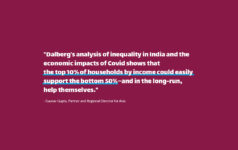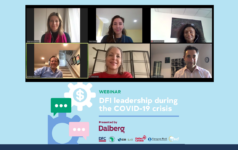Dalberg uses cookies and related technologies to improve the way the site functions. A cookie is a text file that is stored on your device. We use these text files for functionality such as to analyze our traffic or to personalize content. You can easily control how we use cookies on your device by adjusting the settings below, and you may also change those settings at any time by visiting our privacy policy page.
Distance learning strategies hold unmeasured potential to adapt current educational systems to incorporate often-neglected children, and could be a step towards better access and better quality education for youth in developing countries.
The impact on education of the ongoing Covid-19 pandemic is still unmeasured and unknown, but the need for educational revamp is long overdue, with current education systems proving inadequate for millions of youth around the world.
Even before the pandemic, UNESCO’s Institute for Statistics estimated that a total of 258 million children and youth were out of school, the promise of universal primary and secondary education was unfulfilled, and only limited progress had been made in reducing the global number of out-of-school children since the adoption of Sustainable Development Goal 4. Only 50 percent of refugee children had access to primary education prior to the pandemic, compared with a global level of more than 90 percent.1
Prolonged school closures from the Covid-19 pandemic are now expected to lead to even lower enrollment over the long term given the increased risk of dropouts, with vulnerable children and girls in particular at heightened risk. During school closures around the 2013-2014 West African Ebola epidemic, for example, girls assumed more domestic responsibilities and received less home-schooling than boys. When schools reopened, the increased insecurity around household finances meant that boys’ education was prioritized, while girls were expected to generate income, some never returning to school.
The impact of being out of school is profound and long-lasting. A child out of school is not only cut off from quality education, but typically also regular meals, a safe environment in which to develop socially and emotionally, and ultimately a shot at upward mobility. Evidence from past prolonged school closures shows that such disruptions can set generations of children back for life. For instance, the 2005 earthquake in Pakistan led to an average of 14 weeks of school closures, putting affected children 1.5 to 2 years behind their peers in other areas.[1] Losses during closures are likely to snowball after children return to school if they start falling behind because lessons and curriculum do not meet them where they are.
While they cannot replace schools, distance learning strategies hold the potential to adapt current educational systems in ways that actively incorporate those who may otherwise be neglected. Amidst the challenge for governments, the Covid-19 crisis has also created unique opportunities to gain insight and potentially re-think educational methods and tools.
Distance learning solutions – meeting the education challenge at scale
In response to the Covid-19 outbreak, governments around the world have had to move quickly to deploy distance learning where possible and ensure some semblance of educational continuity while schools closed for at least 89% of the world’s 1.7 billion students.2 In developing countries – only 25% of which were ready for any type of distance learning3 – education ministries along with aid organizations, funders, and other actors, have deployed a variety of distance learning solutions along with educational content over publicly-accessible platforms.
Many distance learning programs are drawing on more traditional, “low-tech” platforms to reach children and youth at scale. For example, Rising Academies, a low-cost private school network in Sierra Leone, Liberia, and Ghana, is partnering with local governments to adapt lesson scripts for dissemination via radio and SMS to reach students even in remote areas with little or no internet connectivity.4
Many countries are using a combination of online and offline methods. The Jamaican government, for example, has offered free mobile data access to the country’s educational content, launched educational TV channels, and begun offering printed learning kits to serve over 300,000 of the country’s students without reliable access to the internet. In India, in addition to providing content over digital channels like WhatsApp, TV, YouTube and educational apps, many states have been distributing textbooks, worksheets and assignments, and encouraging teacher home visits and community-level open-air classes with safety guidelines and equipment.
Understanding what works and for whom – foundation for reform
Distance learning initiatives have been designed to be rolled out quickly and to reach as many children as possible. But the immediacy of the crisis has left limited space to understand how accessible, relevant and effective the different programs have been in supporting children’s learning, and whether access and relevance varies depending on children’s geographic location, gender, and capabilities.
Lack of evidence is a challenge that has both immediate and long-term implications for decision makers in government, as well as educators, social sector actors and education companies.5 In a 2017 study that Dalberg conducted alongside an impact investor in Latin America, Africa, and Asia, the lack of evidence around which edtech solutions are most effective emerged as one of the main barriers for widespread and effective use.
A natural next step could be to gather performance data (e.g., rapid learning assessments) and information on the current situation by surveying and interviewing policy makers, edtech companies, schools, and social sector actors, as well as teachers and parents themselves to determine what is needed to improve learning conditions in the short- and long-term.
Dalberg recommends five steps towards educational reform
Covid-19 has presented an opportunity to build understanding about what distance learning and edtech solutions are effective, for whom, and in what contexts. This information could help lay the foundation for educational transformation in developing countries that would lead to better access to education for those who don’t have it, and better quality distance learning solutions for those who do.
To deliver on short- and long-term priorities, governments, educators, funders, and technology and content providers can take several strategic steps:
- Identifying gaps in deployment of distance learning solutions, and addressing uptake challenges to ensure that every child has access to educational opportunities during the Covid-19 crisis
For leaders across the education ecosystem, the immediate objective should be to ensure that as many students as possible can and are using the distance learning tools available. They should identify which students are falling through the cracks and why. With this knowledge, ministries and schools can direct limited resources to measures such as technology changes, new applications and adjustments to pedagogy, that can increase access and improve learning for the maximum number of students excluded.
These efforts should go beyond simply reaching students who were previously in school, but also to properly identify and include the children and youth who were out of school before the pandemic, such as refugees. Given recent developments in distance learning, now may be an opportunity to bring education to these children, potentially creating a path back to school for them once the emergency is over.
- Developing rich profiles of student segments that can inform and tailor content, tools and methods according to the different needs.
Policy makers and social sector actors in developing countries need information about students and their circumstances to tailor their distance learning interventions. “Market segmentation” that factors in different levels of vulnerability is necessary for circumstances such as access to food, water, and safe shelter, gender and family conditions. Segmentation factoring in varying levels of access to basic educational resources is also necessary, like teachers, books, and access to technology such as radio, TV, SMS and internet. Segmentation requires both data-driven and human-centered approaches, with the approximate number of students sought out based on segments it represents in a specific country; what their key needs and aspirations are; and what interventions to prioritize in the short-, medium-, and long-term.
- Conducting a rapid analysis of key challenges and best practices to deploy distance learning at scale in developing countries
There is a strong likelihood – based on the epidemiological models – that many countries will need to continue with school closures, or at least some restrictions on physical access to schools, for a year or more in order to avoid or mitigate future waves of the virus.
Between now and then, lessons from early experiences with large-scale distance learning can be used to develop improved plans for distance learning and edtech applications. These plans should include several scenarios to prepare ministries and schools for different restriction options.
This evaluation and planning work should also inform longer term projections about the effects on learning that different kinds of restrictions have on school access – and corresponding distance learning or edtech solutions that could be deployed. With this data, governments can make decisions about school closures or restrictions that balance health and education objectives.
- Identifying how newly adopted distance learning tools can continue to be developed and utilized after Covid-19 to raise the level, quality and reach of education even after schools reopen
Looking to the long-term, new education strategies and technologies that are now being deployed for distance learning – in many cases for the first time at large scale – should lay the foundation for enhanced education systems post-Covid-19. For example, blended learning approaches that take advantage of technology’s ability to provide greater flexibility, such as more tailored content and pace can augment in-person efforts. We should have a better understanding and evidence base around strategies and technologies that can enhance learning and expand access most effectively. We would then be in a position to plan for transitioning to post-Covid education systems, retaining edtech solutions that increase quality and access. Education systems will also potentially gain resiliency against future crises and emergencies with better distance learning and edtech solutions in place and ready to be deployed if and when schooling is interrupted in the future.
Of note is that edtech is by no means a panacea for all the challenges in education. This crisis has been a reminder that teachers are essential in both routine and emergency situations. Therefore, investing in teachers and schools should remain a top priority. Rather than edtech being viewed as a replacement to teachers, the question should be: how can edtech best support the noble and crucial work teachers do every day?
- Bringing together coalitions of actors to close the access gaps to education
Various actors, including governments, civil society organisations, philanthropies and private edtech companies have mobilized to provide distance learning solutions around the world. These efforts can be better coordinated to design and roll out strategic solutions and policies that help ministries and schools close access gaps, addressing training and support, connectivity, and software, hardware, and content availability.
Governments, schools, teachers, and parents will need training and support to integrate new technologies and tools into their educational approaches and overcome barriers that limit the access of certain populations, such as women, to digital solutions. Educators need to be made aware of helpful and relevant initiatives, such as Zoom’s teacher training resources on remote learning, Edpuzzle, the video lesson creation software, and various other online classes and tools, such as Buncee, for teachers to build and design classes.
Through public-private partnerships, further measures could be taken to overcome access issues. For instance, Telecom providers are working to reduce the high prices of data in certain regions – Vodacom has zero-rated its education content in Tanzania, and MTN has announced a 50% cut to data rates in South Africa.6 Other measures will be needed to overcome unreliable electricity networks, low mobile internet coverage – 29% on average across Africa – and slow internet speeds – 3 Mb/s in Namibia.
Limited awareness and understanding of available solutions, lack of basic digital literacy, or lack of affordable and adapted edtech solutions, such as those that support local language teaching, can be overcome by drawing on local resources and partnerships to increase accessibility to edtech solutions.
Recovery post-Covid-19 – and reshaping Education
While the Covid-19 crisis has created unprecedented challenges for education systems, it has created a unique moment to gain insight and re-think educational methods and tools. The immediate priority in the weeks ahead will continue to be effectively deploying and scaling distance learning, particularly for the most vulnerable children and youth. Attention should also now shift to strengthening solutions and maximizing their reach and effectiveness – and to expanding access where distance learning has not yet reached large numbers of children.
[1] Research on Improving Systems of Education, Human Capital Accumulation and Disasters: Evidence from the Pakistan Earthquake of 2005, 2020
1. UNHCR, “Missing Out: Refugee education in crisis,” September 2016
2. UNESCO, “COVID-19 Education Response,” April 2020
3.Miao, F. UNESCO webinars on COVID-19 education response 5th edition, 17 April 2020
4.World Bank, “How countries are using edtech (including online learning, radio, television, texting) to support access to remote learning duringthe COVID-19 pandemic,” April 2020
5. https://nextbillion.net/promise-of-edtech-adoption/
6. SkyWire, “Telkom zero-rates education websites amid coronavirus outbreak,” 16 Mar 2020








